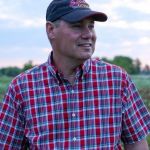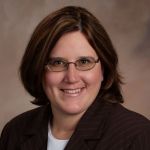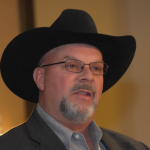
January 13, 2021 -- An Interview with Jimmy Emmons 2021 Soil Health U - Keynote Speaker
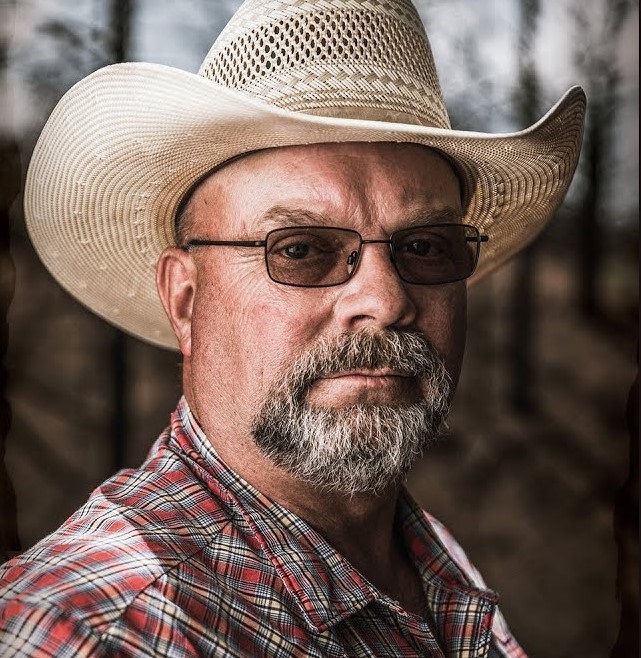
Regional coordinator for the Southern Plains Region – FPAC (Oklahoma) – Third generation farmer and rancher Jimmy and his family own and manage 2,000 cropland acres and 5,000 rangeland acres in Dewey County, Oklahoma. Jimmy serves as president of the Oklahoma Association of Conservation Districts and is on the Dewey County Conservation District board. As FPAC regional coordinator for the southern plains region, he serves Oklahoma, Texas, New Mexico, Colorado, and Kansas.
Jessica: Welcome, Jimmy! You will present the “State of the State of Soil” from the eyes of an Oklahoma Soil Health Steward and your work with USDA Farm Production. You will provide a historical review of soil health related to civilization, taking listeners on a journey up to the present-day status of soil health in the United States. I understand this will be the first time you’ve given this unique presentation, “The State of the State of Soil Health.” This information is pretty crucial; tell me more.
Jimmy Emmons: Yes, my presentation title models the United States of America “State of the Union” address initially designed by George Washington to communicate the union’s status and the country to the United States citizen. I will bring that same message to the conference next week from the perspective of the status of soil health. I’ll cover where we’ve been, how we got started, where we’re currently at, and where we can go with regenerative agriculture.
And I’ll explain in pretty good detail what we’ve done to our soils over the years and how we degrade them, how we’ve caused water quality issues to the Gulf of Mexico, and try to explain the problem. But I will also highlight the solution of soil health. I will stress that producers can be the solution and not the problem in agriculture.
This would be the first time I’ve done this particular talk, and I’ll try to give a hefty summary of where we’re at, not only here in the middle part of the country, but also with soil and soil health across the United States.
Jessica: That’s excellent, Jimmy. Sounds very presidential. And you’re no stranger to speaking to large groups about soil health. Right now, what’s your greatest hope for soil health right now?
Jimmy Emmons: This talk will be an eye-opener to the American producer and the American consumer to learn where we’re at and what we can do with the tools available to improve soil health. We are in an extreme weather pattern right now, which is described by some as a whiplash. We can go from a flash flood to a flash drought, sometimes in the same season. We’re seeing huge swings in the weather, long periods of drought, excessive moisture falling with flooding, all with wildfires in between. So what can we do as a nation and as producers and consumers to help improve things? How can soil health help?
Jimmy Emmons: My goal is to open everybody’s eyes a little bit more, to understand the soil properties and how we can fix this problem and be part of the solution instead of being the problem. We have lots and lots of erosion still today in the United States. And that’s just unacceptable. Once the soil is gone, you can’t replace it. The question is, how do we regenerate soil, get it back to where we were in the beginning so that we can be more profitable, less dependent on inputs. That’s the goal.
Jessica: Thank you for taking the time to focus on the American producer in this talk and the American consumer. COVID has highlighted issues with the supply chain, and it’s been abundantly clear our consumer is learning more about where their food comes from. As producers, let’s provide the message from the soil up. It sounds like a win-win for us all, right?
Jimmy Emmons: Indeed, Jessica. I think it can be a win-win for us all once we understand the key components of success. For me, success begins in the soil.
-Jessica Gnad
January 6, 2021 -- An Interview with Kris Nichols, 2021 Soil Health U - Keynote Speaker
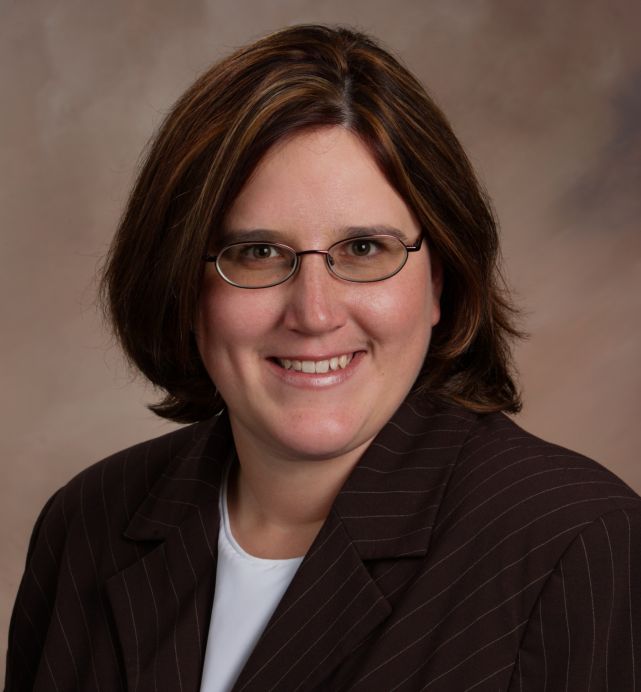
Soil Microbiologist – KRIS Systems Education & Consultation
Jessica: Joining me today is Dr. Kris Nichols, who is one of our keynote speakers at Soil Health U 2021 on January 21st. Welcome, Kris! Thanks for joining Soil Health U.
Dr. Kris Nichols: Thank you so much for having me.
Jessica: Kris, you are a leader in the regenerative movement to regenerate soil for healthy crops, food, people, and the planet. And currently you hold the position of research director at MyLand Company, LLC in Phoenix, Arizona, and you are also the founder and principal scientist for Knowledge for Regeneration and Innovation in Soil Systems Education and Consulting. I consider you a farmer’s farmer. Tell me a little bit about how you got here, your upbringing growing up on a farm, and how you have worked in so many different geographies, regenerating soil.
Dr. Kris Nichols: I grew up on a farm in southwestern Minnesota. My dad purchased the farm the year I was born. So, my whole entire life, my family has been farming the same land. We’re a multi-generational farm family. And, really, when I look at the systems, I’m really focused on the idea that soil is universal. And so, I’ve worked in Minnesota and the upper Midwest. I’ve worked in the Great Plains in the Dakotas and I’ve also worked with farmers in Kansas and Nebraska. I’ve done research and work over in the sub humid Mid-Atlantic region. And I’m now working in the desert Southwest. And, again, what really unites all of those eco regions is looking at regenerating the soil.
Jessica: Absolutely, it’s the soil! So, in your presentation for Soil Health U this year, you’ll speak about regeneration principles and the tool box for producers to regenerate soil. You stress regenerative agriculture needs to be viewed through the lens of a systems approach. So, we’re not necessarily creating a check box of practices do’s and don’ts. Tell me a little bit more about regeneration principles and toolbox and how does that, in your mind, set farmers up for on-farm innovation.
Dr. Kris Nichols: Again, it’s really about the soil and the biology within the soil and how we’re going to be able to regenerate that. And we need to use a systems approach. It’s sort of changing the paradigm of how we’ve focused on agriculture in the past, where what we’re doing is really looking at these interactions between the biology, the chemistry, the physics, and the geology in such a way that we’re taking all of the components together.
“And one of the things that I love about regenerative agriculture is the fact that it is not a prescription plan. It isn’t a thing where you’re being told what to do, but farmers, I think, are true innovators and ingenious people and they can really be able to make these changes that are going to be incredibly important to how the system is going to function.”
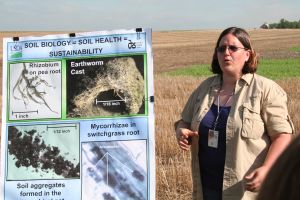
We’re not looking just above ground, but we’re looking below ground and that integration, integrating livestock and other things like that. So, it really is trying to take this systems approach. And one of the things that I love about regenerative agriculture is the fact that it is not a prescription plan. It isn’t a thing where you’re being told what to do, but farmers, I think, are true innovators and ingenious people and they can really be able to make these changes that are going to be incredibly important to how the system is going to function. And so, what I love is that you have a lot of options and opportunities within regenerative agriculture. Again, the soil is universal, the principles are universal, but the tools that you can put into place, there’s a multitude of those tools that you can use.
Jessica: This is awesome. Thank you so much, Kris. I look forward to hearing your presentation at our virtual event on January 21st. We’re going to kick things off at 8 AM and go until about 12 PM. We will feature a breakout session, which I would consider the next best thing to our hallway conversations typically had at Soil Health U, so if anybody out there, now is the time to get registered. It’s $25 on soilhealthu.net or if you’re an HPG subscriber, we do have a free code in this week’s High Plains Journal that was mailed out this week. So, once again, Kris Nichols, thank you for joining me today and I look forward to the event.
Dr. Kris Nichols: Thank you so much. I look forward to the event, as well.
Registration for the Virtual Soil Health U is open at www.soilhealthu.net. High Plains Journal subscribers check your current issue for a free registration code. The cost is $25 for non-subscribers. Registration will be required to access the live event and the recordings of the presentations as well as the breakout idea exchange sessions. Watch www.soilhealthu.net for updated programming and registration notes.
The virtual Soil Health U will feature our three keynote speakers during morning webinar sessions on January. 21st. New this year, we plan to offer virtual breakout sessions so that attendees can have more time for idea exchanges and further explore topics with their fellow attendees, speakers and other soil health notables in the field.
-Jessica Gnad
January 5, 2021 -- An Interview with Rick Clark, 2021 Soil Health U - Keynote Speaker
Rick Clark is a fifth generation farmer from Williamsport, Indiana. The main goal on the farm is to build soil health and achieve balance with Mother Nature. Rick has developed and is constantly improving a systematic approach to regenerative farming. The farm strives to be a low-cost input producer while maintaining an increase in yield year over year. The farm is 100% NGMO, 100% no-till, and 100% cover crop. Rick is currently transitioning the farm to organic. He is most proud of developing a system of organic farming that uses no tillage. He will suppress weeds with cover crops. Rick cares deeply about human health as well, that is one of the main drivers behind his organic no-till style of farming. Rick is building a system that will be viable and sustainable for generations to come.
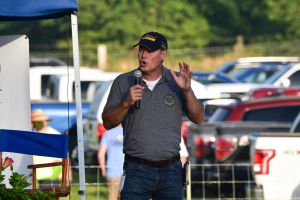
Rick Clark: Thank you so much for having me speak, Jessica. It’s a pleasure. Thank you.
Jessica: Of course! In your bio, you have been recognized for outstanding conservation efforts on the farm as well as leadership in advancing sustainable agriculture. And the title for your keynote presentation at Soil Health U is Leading With Soil Health. Tell me what this means to you.
Rick Clark: Yes, Jessica, this is very important. The number one driver of our systematic approach to our farming method is soil health. And I’ve said many times I will sacrifice yield to maintain soil health. And I will most definitely do that because it’s taken us so long to get to where we are today that I am not willing to give that soil health up.
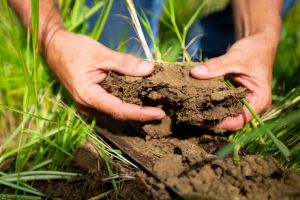
“And I’ve said many times I will sacrifice yield to maintain soil health.”
Jessica: Absolutely. And you know, I’ve heard you talk about that before and I know that you’re going to dive into what that means. I know a lot of listeners are probably interested right now, sacrificing yield for soil health. But you also have pioneered an inventive systems approach to soil health. And you’re going to be talking about this a lot, it’s what you call “farming green.” By farming green through soil health, you increase your profitability while dramatically improving environmental outcomes. Tell me more.
Rick Clark: Right, you are exactly correct. Farming green extends the life of the cover crops way longer into the growing seasons. So that cover crop, whatever it was intended to do, if it was a cereal grain it’s going to sequester nutrients, it’s going to give you armor to the soil, it’s going to give you erosion control. If it’s a legume, you let it go further into the season like past Mother’s Day, and now it’s fixing all that free nitrogen for you that it’s pulling out of the atmosphere. Those are the things that I think are what really expedited our soil health journey, is because by farming green, which what I mean by that is we’re planting our cash crop of corn and soybeans into a living, growing, green cover crop and not terminating sometimes up to 35 to 40 days. We are pulling those nutrients deep from within the profile, recycling them back to the surface, and they go back down through the profile to be then available for the cash crop.
Jessica: Excellent. So we’re talking about how many acres here?
Rick Clark: About 7,000.
Jessica: Seven thousand? That is very impressive. And approximately how long have you been working on this?
Rick Clark: We’ve been no-tilling for 15 plus years and cover cropping now for 11 plus years. And we have to be very careful here, Jessica. There’s a couple of critical things that we have to pay attention to. Number one is, if there are beginners listening, we have to start easy and there has to be a success that first time out for a beginner. Because I’m afraid if there’s no success, they may not come back to this long term. And the second thing we have to be aware of is this is a very advanced system that we’re in and you can very easily get in over your head if you’re not careful. I don’t mean to scare people, but we have to be aware that this is way different than the way a lot of people are currently farming.
Jessica: I think this is fantastic. I really look forward to hearing more about your presentation. I know you and me, we have had multiple conversations in the past, and I can’t wait for you to share your system of farming with our attendees at Soil Health U. But I think that your message along with some of the other speakers, people are going to get a really well-rounded look at what soil health can do for you. Once again, Rick Clark, thank you for joining me today, and we can’t wait to see you at Soil Health U.
Rick Clark: Thank you, and I can’t wait to be out there to see everybody west of me. I greatly appreciate it, talk to you soon.
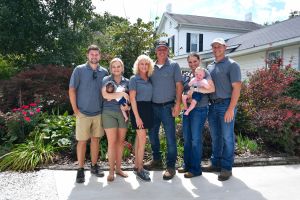
Registration for the Virtual Soil Health U is open at www.soilhealthu.net. High Plains Journal subscribers check your current issue for a free registration code. The cost is $25 for non-subscribers. Registration will be required to access the live event and the recordings of the presentations as well as the breakout idea exchange sessions. Watch www.soilhealthu.net for updated programming and registration notes.
The virtual Soil Health U will feature our three keynote speakers during morning webinar sessions on January. 21st. New this year, we plan to offer virtual breakout sessions so that attendees can have more time for idea exchanges and further explore topics with their fellow attendees, speakers and other soil health notables in the field.
-Jessica Gnad
November 20, 2020 -- Making Rain Matter
In the Bible, Jesus tells a parable about a seed falling on poor ground and producing nothing, and another seed falling on fertile soil and growing fruit. Rain will do the same thing depending upon where it lands.
An inch of rain will produce much more yield falling on healthy soil than on degraded land. The condition of soil makes an incredible difference in how much rain infiltrates and is put to use on pastures and cropland, versus how much runs off and does no good. On severely abused soils, an inch of rain may not even penetrate the surface.
But why? The reason is soil structure. Healthy soil has a “cottage cheese” texture due to the presence of microbial “glues” that hold particles together. There’s lots of pore space between the particles (called aggregates) for water to soak in. These aggregates contain highly fertile decaying plant and animal material, called organic matter, that absorbs water like a sponge. Ideally, the soil surface will be covered with crop residues, cover crops, or stockpiled forage. Surface cover slows down water travel and keeps evaporation rate down, giving water more time to sink into the soil.
When rain falls on degraded soil where the aggregate structure has been destroyed by mismanagement, there’s nothing to slow it down. It can’t sink into the soil, because there are no pore spaces. The soil surface becomes an impermeable “cap” when left bare and unprotected. Rain has nowhere to go, so it runs off. In the absence of microbes to glue soil aggregates together, the soil takes on a powdery form that washes away with the rain. Expensive soil amendments you’ve applied erode with the topsoil. Soil surface temperatures rise when exposed to the sun, which along with wind, speeds up evaporation.
How does soil get damaged to the point where rain does no good? Frequent tillage exposes soil organic matter to oxygen, allowing aerobic microbes to eat it all up quickly. Having depleted their food source, microbes die. Without microbes to maintain stable soil aggregates, the “cottage cheese” breaks down into powder. This is how and why compaction happens. Regular overuse of synthetic substances like anhydrous ammonia, pesticides, and herbicides also kills soil microbes, resulting in the collapse of the aggregate structure.
On pasture, leaving livestock in the same place too long causes overgrazing. This exposes the soil surface to the elements. Soil temperatures quickly rise too high for microbes to survive. Without microbes, nutrient cycling stops, and plant vigor declines. Plant roots growing and sloughing off cyclically when grazed in accordance with the plant’s life cycle contributes significantly to soil fertility and microbe maintenance. But this process is severely impaired when plants are both over- and under grazed. Over- and undergrazing happens in the same pasture simultaneously (to different plants) when grazing density is too low and grazing time is too long.
You can fix poor soils with regenerative management practices. Some people think high rainfall is needed for soil health management to work. This couldn’t be farther from the truth. In actuality, the less rain you get, the more significant difference regenerative practices make! It’s extremely important in dry climates to make sure that every drop of rain that falls is absorbed into your soil and kept there for use by plants and microbes. At Soil Health U in January, I will show you how to set your soil up to make the most out of limited rainfall.
–Meg Greski
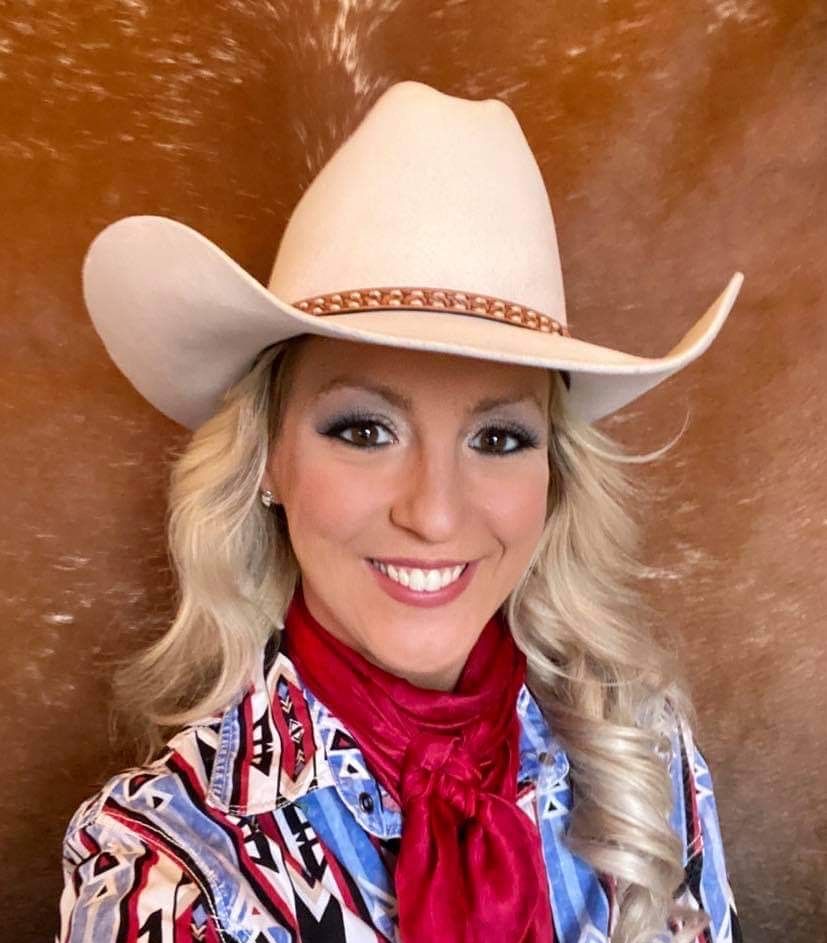
Meg Greski is a speaker, writer, consultant, and ranch hand. She has forged her own path into ranching and has been on a mission to extend the reach of regenerative ranching since high school. A graduate of West Virginia University, Meg earned her bachelor’s in animal science and ag business. She was also once an intern for grazing expert Greg Judy. Meg has worked on farms and ranches in seven states and ran her own 100% grass breeding stock operation for six years. Meg teaches regenerative livestock management through writing, speaking, and consulting in Alva, Oklahoma.
November 13, 2020 -- Confessions of a Soil Health Content Consultant
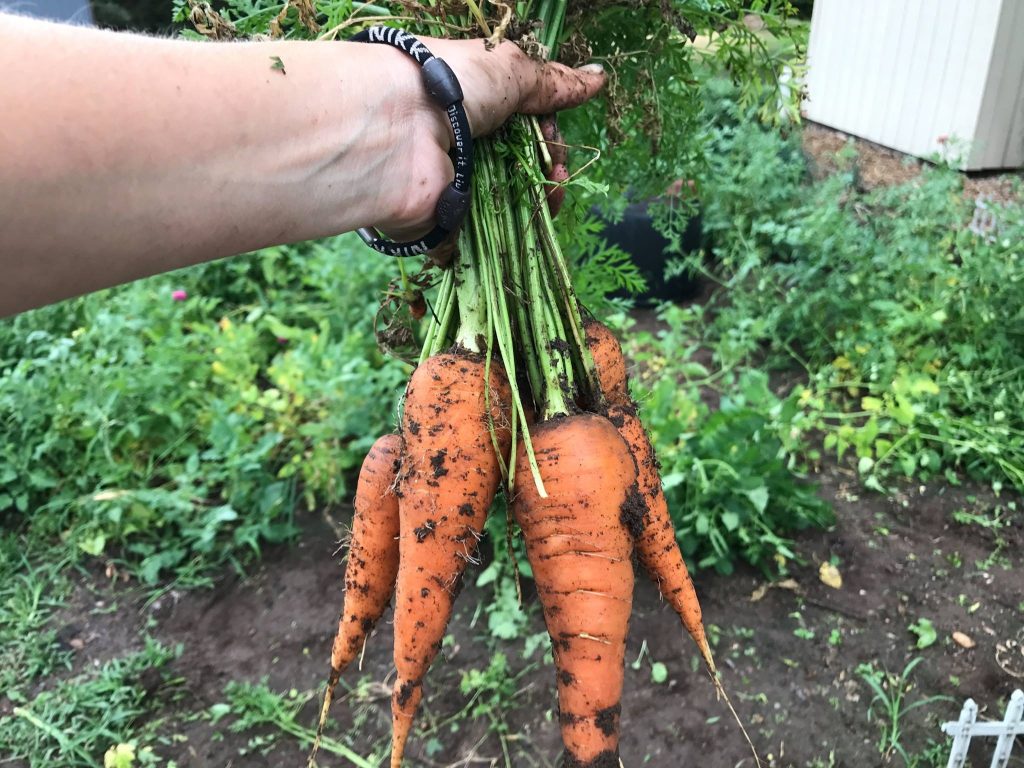
Gasp! I didn’t grow up on a farm. I didn’t grow up having grandparents who farmed. I grew up in central Topeka half my life; then, I experienced rural living for the first time when my family moved outside of Topeka near Meriden, Kansas. It was a dreamy property, a 100-year-old farmhouse with almost an acre to roam. The former owner of this home planted various fruit and nut trees, which we enjoyed along with the well-established grapevines.
When we arrived, the first thing my parents did was put their personal touch on the place. My mother was a landscaping whiz and incorporated edible plants such as lavender, leafy greens, and basil into her designs. My stepdad was the tomato plant king. Even asking one summer, “Are 48 tomato plants too many?” Admittedly, gardening was pretty nerdy to a teenager who was more interested in football games and hanging out with friends. The gardening bug had not bitten me at this point in my life.
Fast forward a few years and I’m walking up to visit an open house at a property I labeled “The Donkey Ranch.” In my marital bliss of just a few short months, my husband urged me to consider a home he found out in the country. Almost 7 acres and the home to about 45 donkeys. The online listing had multiple pictures of the donkeys on a very overgrazed pasture, that was mostly bare dirt. There were cactus and yucca plants and not much green living grass. But there was a garden plot outside the donkey pen. A lush, robust plot showcasing a very vibrant asparagus patch. Maybe it was the newlywed speaking, perhaps it was my pregnant lady food craving for asparagus, but I said yes to The Donkey Ranch.
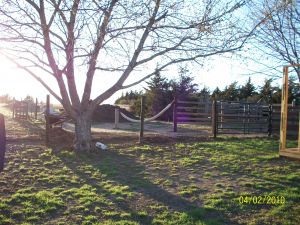
(Caption: Pasture area with composted donkey manure pile in the background)
When we closed on our new homestead, the previous owners gifted us two donkeys as a token of appreciation. The mama, named Daisy, was pregnant just like me. (Insert funny story of how Daisy birthed the largest baby donkey ever, named Poohead). I don’t know for sure if this was the turning point in my life, becoming a donkey rancher, but living out in the country with a plot of land to grow food and a family changed the core of who I am today.
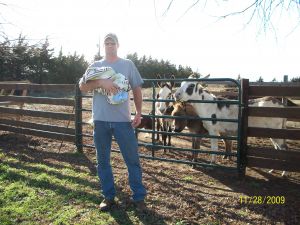
(Caption: Shannon Gnad holding newborn son, Jack, while the Donkey’s overlook.)
My husband and I spent the next ten years working to improve this property. The home needed work. The lawn was a mixed species of native weeds. There was little landscaping keeping the topsoil from running off around the foundation of the house every time it rained, and the back pasture was severely overgrazed. We had a lot of bare dirt. We also realized we’d have to deal with significant hard compaction in the garden plot, making gardening harder than we anticipated.
Although Shannon and I both shared a passion for gardening, we realized we had a lot to learn about growing food on a large scale. Shannon joined the Pratt County Master Gardener program through Kansas State University Research & Extension, where he learned horticulture pest and weed management techniques. We agreed early on that our homestead would adopt a chemical-free philosophy, and therefore we decided to advance our learning about alternative farming methods. What we found, we now know as the Soil Health Principles. When you follow these principles, you can regenerate your soil.
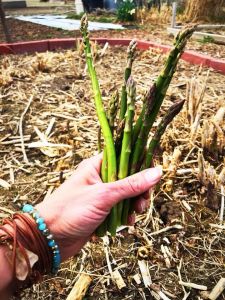
(Caption: Author Jess Gnad picking asparagus, 2017)
What are Soil Health Principles? Soil health is “the continued capacity of soil to function as a vital living ecosystem that sustains plants, animals, and humans.”The soil health foundation consists of five principles: 1. soil armor; 2. minimizing soil disturbance; 3. plant diversity; 4. continual live plant and root; and 5. livestock integration. Over the course of many years, we adopted the Soil Health Principles on our backyard homestead. We began to leave “litter” in the garden by leaving leftover plants and adding fall leaves. We minimized tillage and after 7 years went completely no-till, which was hard for Shannon who felt a deep sense of accomplishment by tilling. This was overcome by eventual decreased weed pressure and fewer pests. We switched to using heirloom seeds and made sure we grew crops like clover for ground cover. We added in permanent herb patches for continual living roots. We sometimes even let our flock of chickens graze the garden.
As an agronomist and K-State Master Gardener, my husband Shannon knew we could utilize the donkeys’ manure to create our compost to amend the soil. So that’s what he did. A few hours every night after work that fall, a borrowed tractor made a compost we affectionately called our “black gold.” We flipped, turned and rotated that pile of manure, which made our compost many times over ten years. We even considered taking some of it with us when we sold the property in 2019, but decided, just like the donkeys were gifted to us, we’d leave our masterpiece to the next owners of The Donkey Ranch.
Learning the Soil Health Principles set the foundation for my work as a soil health content consultant. Seeing is believing and getting to witness healthier soil that grew more plentiful crops, reduced pest and weed pressure, and eliminated compaction was proof enough. Working with companies like High Plains Journal, Regen Farming News and Soil Regen, I’ve been able to share the soil health message with many others. And this Jan. 20 to 21, 2021 we will share the message at Soil Health U. Join us!
![]()
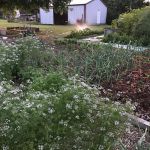
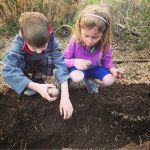

-Jessica Gnad
November 3, 2020 -- Conference Season

Each year I look forward to “conference season” beginning after harvest in November until spring planting. During this time of year, farmers and ranchers connect, share, and exchange ideas on how to improve their operation for the next season. Along with some tall tales and maybe a few cold ones, we gather to share our peaks and pits of farming.
We all know 2020 has brought many changes to the way we live, and expect 2021 to hold its own host of obstacles. For sure, we must continue our upward trajectory toward better farming practices to ensure our rural communities’ sustainability, so the show must go on. Since July, I’ve worked with a dedicated team at High Plains Journal to determine the best delivery platform for Soil Health U 2021. Although we can’t predict the future, we will host this event in-person as of right now.
This fourth year of Soil Health U will cover innovative education, breakout sessions, producer panels, and a robust soil health trade show, bringing industry knowledge and forward thinking to attendees. Leaders in soil health have been slated to speak, including Rick Clark, a fifth-generation farmer and owner of Farm Green; Kris Nichols, Ph.D., soil microbiologist and founder and principal scientist of KRIS Systems Education & Consultation; and Jimmy Emmons, a third-generation farmer and rancher, regional coordinator for the Southern Plains Region- FPAC within USDA.
Registration is now open for just $99. Student registration is $50.
Secure your spot at Soil Health U 2021 by registering now!
The Soil Health U event team monitors the COVID-19 situation closely and is committed to providing attendees and exhibitors with the latest information in a timely manner. The health of attendees and exhibitors is our priority. We will continue to monitor the COVID situation by working with state and local leaders to ensure our attendees’ and staff’s safety. Our community’s safety and well-being is our top priority, and we are committed to maintaining regular communication regarding changes to the delivery of the event.
COVID-19 Updates can be found HERE.
High Plains Journal sponsors soil Health U & Trade Show. Since 1949 HPJ has been the weekly source for news, markets, and commentary for farmers and ranchers in 12 states across the Plains.
High Plains Journal has a proven track record of combining internationally acclaimed soil health education with top-notch innovation exhibits during this two-day event. Whether you are well versed in regenerative agriculture or brand new to the concept, there’s something for everyone at the 2021 Soil Health U & Trade Show. At Soil Health U, attendees will learn how to unleash the power of healthy soil.
-Jessica Gnad
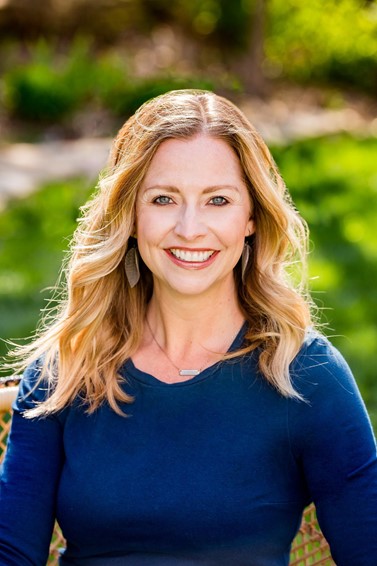
Currently hailing from Manhattan, Kansas, Jess Gnad’s path in soil health started with a curiosity about healthy food options in rural communities. It was while she was living in Pratt, Kansas, over the past decade and starting her family with her husband that Jess worked to form a farmer’s market, a local food coop, and a Regenerative Ag School Garden with support from Annie’s Homegrown Grants for Gardens. She served as an executive board member for Kansas State University Research and Extension, and as a healthy food/farm consultant with Pratt Regional Medical Center’s Health Coalition. She counts her background as a row crop farmer and an avid gardener growing fruits and vegetables as her foundation for her passion for regenerative agriculture. Jess is a “Jess of all trades” and can also be found coordinating Soil Health U and working as an advisor for Soil Regen.
